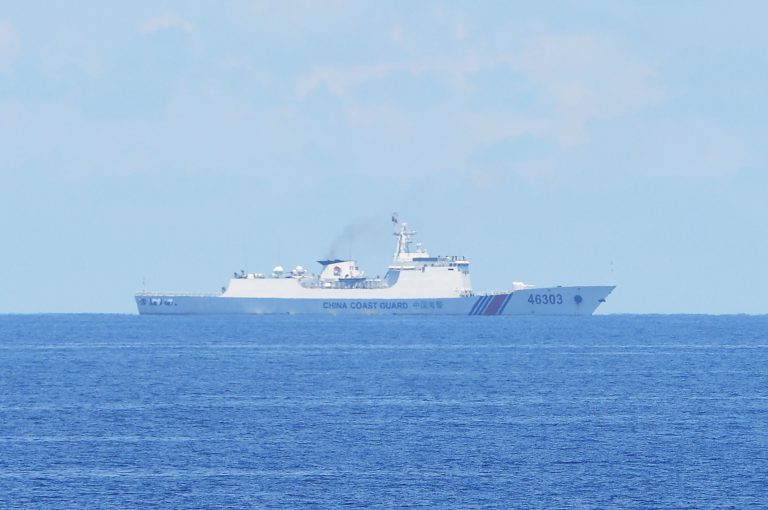Since March, over 200 Chinese vessels have gathered at Whitsun Reef, a disputed island in the South China Sea, triggering a new round of diplomatic argument.
Chinese diplomats have said the boats were sheltering from rough seas. However, after the weather improved, these so-called “fishing boats” remained in the area.
On March 25, after the Philippines’ repeated diplomatic protest went unanswered, the Philippine military ordered the deployment of more warships in the South China Sea on a “sovereign patrol” mission.
Experts and investigative journalists suspect that Chinese civil vessels, including fishing boats, often have ties to the Chinese People’s Liberation Army, providing Beijing with a “maritime militia.”

Harry Roque, a spokesman for Philippine President Rodrigo Duterte, said at a press conference that the president is “very worried” and that “any country would be concerned about the number of these vessels.” He also said that the President, during a meeting with Chinese Ambassador Huang Xilian, reiterated the 2016 ruling by an international court on the sovereignty dispute between the two countries in the South China Sea.
Success
You are now signed up for our newsletter
Success
Check your email to complete sign up
South China Sea claims
Beijing has long claimed sovereignty over the vast majority of waters in the South China Sea. But in 2016, the Permanent Court of Arbitration (PCA) in The Hague ruled that China had no “historical rights” to the strategic waters.
But Beijing said it does not recognize the ruling and has built artificial islands in the disputed waters equipped with radar, missiles batteries and hangars for fighter jets.
According to the latest satellite images taken by Maxar Technologies, a U.S. space technology company, the second largest “island” in the Spratly Islands, Subi Reef, which China began to turn into an island in 2015, has recently resumed its “land reclamation” project.
In an interview on March 24, former Philippine Supreme Court justice Antonio Carpio, one of the legal counsels that secured the Philippines’ victory over China at the international court in The Hague, said he was “particularly worried” that China – by parking hundreds of ships believed to be manned by its maritime militia at the Julian Felipe Reef (Philippine’s name for Whitsun Reef) – was using the same strategy in occupying Mischief Reef in 1995.
In 1995, China occupied Mischief Reef on the pretext of creating a haven for fishermen.
In recent years, the Chinese Communist Party (CCP) has been reclaiming land, building military projects, and deploying military aircraft and radar in the disputed areas of the South China Sea, raising the alarm of the international community.
On March 23, the U.S. Indo-Pacific Command said that the U.S. cruiser USS Bunker Hill completed a passing exercise with the Australian Navy in the Indian Ocean on March 10, and both sides trained in communication and navigation techniques.
Freedom of navigation in the South China Sea
Great Britain, France and Germany have made announcements to send ships through the South China Sea to exercise the right of “freedom of navigation“.
On March 2, German government officials said that one of the country’s frigates will leave for Asia in August and will pass through the disputed South China Sea on its return journey, becoming the first German warship to pass through the South China Sea since 2002.

(Image: Rebell18190/Public Domain)
On February 8, French Defense Minister Florence Parly also announced that the country’s nuclear-powered attack submarine, SNA Suffren, and support & assistance Vessel BSAM, have been cruising in the South China Sea and other Indo-Pacific waters.
A Canadian navy ship also passed through the Taiwan Strait in January this year, joining Australian, Japanese and U.S. maritime forces that were conducting military exercises in nearby waters.
British Prime Minister Boris Johnson announced earlier in the House of Commons that the British aircraft carrier HMS Queen Elizabeth will cruise the Indo-Pacific waters later this year.
On Sunday, April 4, the Philippines’ Defense Secretary Delfin Lorenzan released a statement, “The continued presence of Chinese maritime militias in the area reveals their intent to further occupy [areas] in the West Philippine Sea [Philippines name for the South China Sea].”
The Philippines have called repeatedly for the Chinese boats to leave Whitsun Reef. The Chinese Embassy in Manila responded by saying it was “completely normal” for Chinese vessels to fish in the area and take shelter near the reef during rough sea conditions. “Nobody has the right to make wanton remarks on such activities,” he added.
As of the 4th, 40 Chinese vessels remain at Whitsun Reef despite improved weather conditions.
Follow us on Twitter or subscribe to our email list














